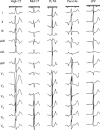Atrial Tachycardias and Atypical Atrial Flutters: Mechanisms and Approaches to Ablation
- PMID: 31114688
- PMCID: PMC6528065
- DOI: 10.15420/aer.2019.17.2
Atrial Tachycardias and Atypical Atrial Flutters: Mechanisms and Approaches to Ablation
Abstract
Atrial tachycardias (ATs) may be classified into three broad categories: focal ATs, macroreentry and localised reentry - also known as 'microreentry'. Features that distinguish these AT mechanisms include electrogram characteristics, responses to entrainment and pharmacological sensitivities. Focal ATs may occur in structurally normal hearts but can also occur in patients with structural heart disease. These typically arise from preferential sites such as the valve annuli, crista terminalis and pulmonary veins. Macro-reentrant ATs occur in the setting of atrial fibrosis, often after prior catheter ablation or post atriotomy, but also de novo in patients with atrial myopathy. High-resolution mapping techniques have defined details of macro-reentrant circuits, including zones of conduction block, scar and slow conduction. Localised reentry occurs in the setting of diseased atrial myocardium that supports very slow conduction. A characteristic feature of localised reentry is highly fractionated, low-amplitude electrograms that encompass most of the tachycardia cycle length over a small diameter. Advances in understanding the mechanisms of ATs and their signature electrogram characteristics have improved the efficacy and efficiency of catheter ablation.
Keywords: Atrial tachycardia; atrial flutter; catheter ablation; macroreentry; micro-reentry.
Conflict of interest statement
Disclosure: SMM has received consulting fees from Boston Scientific and Preventice.
Figures






References
Publication types
LinkOut - more resources
Full Text Sources

